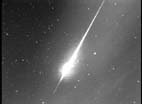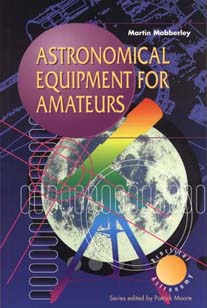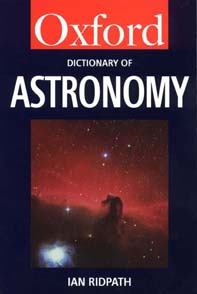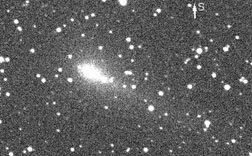
The Journal of the British Astronomical Association
Volume 109, No.1: 1999 February
List of Contents
On this page: Notes and News / Articles / Letters / Reviews / Meetings / Observers' Forum
1997 XF11 - the true story: Brian Marsden speaks at the 1998 October 28 BAA meeting
Notes and News

The 1998 Leonids: a preliminary report / An all-sky image of the 1998 Leonids / Asteroids and Remote Planets Section / Solar Section / From the President
Articles
From the darkness emerging: Pluto and the Edgeworth-Kuiper belt ... Andrew J. Hollis
Pluto is so distant that for the first fifty years after its discovery little was known about it except the parameters of its orbit. Since the discovery of its satellite Charon and the advent of the Hubble Space Telescope our knowledge of the physical characteristics has improved immeasurably. In this paper the known characteristics of Pluto, Charon and the Edgeworth-Kuiper belt are reviewed and observations by Section members are reported. In addition a study of the orbital characteristics over the period from -2.3Myr to +2.1Myr is presented. (5 pp)
Comet Bennett 1969i ... Michael J. Hendrie
On 1969 December 28, our member Jack C. Bennett in Pretoria, South Africa, discovered a small, diffuse comet of 8.5 magnitude. The discovery was made during a regular programme of sweeping for new comets he had been carrying out over several years. The comet was in Tucana, declination 65° south. Precise positions were soon obtained at the Perth Observatory, Western Australia, by Harris, Candy and Gans. The orbit computed by M. P. Candy, a former Director of the Comet Section, showed the comet to have a perihelion distance of about 0.5AU and an inclination close to 90°. Our Comet Section Director and Circulars Editor S. W. Milbourn noted in BAAC 515 that comet Bennett was 'likely to become a bright naked-eye object as it moves quickly north at the end of March.' We were not to be disappointed. (8 pp)
A mathematical method for identifying lines in stellar spectra ... Jack Martin
This paper shows how to calculate the wavelengths and identify the corresponding elements that are present in the spectra of seven types of stars which make up the spectral sequence, by explaining and using the nearly linear relationship between the distances and wavelengths of the lines produced for each spectrogram, using a diffraction grating as the disperser. (3 pp)
The design and construction of 'Astraea' roll-off roof observatory ... Mark K. Herbert
I am ready to observe within five minutes of opening my observatory door. This is how long it takes to unlatch and roll back the roof, power up the telescope drive and uncover the optics. Closure of the observatory occurs in the same timescale. Having a permanent astronomical observatory is a convenience that I could no longer do without. (7 pp)
Jupiter without satellites, 1600-1799 ... Jean Meeus
The planet Jupiter sometimes appears to be without moons, when the four Galilean satellites are simultaneously invisible because they are passing across the planet's disk (transit), are behind the planet (occultation), or are in its shadow (eclipse). The occurrence of such events is investigated. (2 pp)
Index to volume 108 (4 pp.) .... prepared by R. A. Marriott
(Copies of any of these articles may be ordered from the BAA office.)
Letters
- When Pluto becomes the ninth planet ... Peter Owen & Jean Meeus
- Tracking down targets by their chemical signature ... Maurice Gavin
- Alternative spectrohelioscope designs ... George Y. Haig
- W. D. Verschoyle's 'anti-gravity device' ... W. J. Williamson
- Enigmatic bright objects near the Sun ... Roy Panther
- Telescopic limiting magnitudes ... Christopher Newman, Bob Neville, Gordon E. Taylor & Jacqueline Mitton
Read the letters here
Reviews
 Astronomical Equipment for Amateurs by Martin Mobberley Springer-Verlag, 1998. ISBN 1-85233-019-8. Pp xiii + 266, £19.00 (pbk.)
Astronomical Equipment for Amateurs by Martin Mobberley Springer-Verlag, 1998. ISBN 1-85233-019-8. Pp xiii + 266, £19.00 (pbk.)
reviewed by Bob Neville
- New Trends in Astronomy Teaching: IAU Colloquium 162 by L. Gouguenheim, D. McNally & J. R. Percy (Eds.) Cambridge University Press, 1998. ISBN 0-521-62373-1. Pp xv + 352, £45.00 (hbk.)
reviewed by Richard McKim
- The Search for Life on Other Planets by Bruce Jakosky Cambridge University Press, 1998. ISBN 0-521-59165-1 (hbk), 0-521-59837-0 (pbk). Pp ix + 326, £35.00/£12.95.
reviewed by Edward Hanna
- The Universe Revealed by Pam Spence (Ed.) Mitchell Beazley, 1998. ISBN 1-84000-065-1. Pp 192, £25.00 (hbk)
reviewed by David Reid
- Nautical Astronomy in New Zealand: The Voyages of James Cook by Wayne Orchiston Carter Observatory, New Zealand, 1998. ISBN 0-473-05303-9. Pp 131, $NZ 39.00 (hbk)
reviewed by Ian Howard-Duff
 A Dictionary of Astronomy by Ian Ridpath (Ed.) Oxford University Press, 1997. ISBN 0-19-211596-0. Pp. xiii + 536, £7.99 (pbk.) reviewed by Jacqueline Mitton
A Dictionary of Astronomy by Ian Ridpath (Ed.) Oxford University Press, 1997. ISBN 0-19-211596-0. Pp. xiii + 536, £7.99 (pbk.) reviewed by Jacqueline Mitton
Observers' Forum
 Comet C/1998 U5 (Linear)
Comet C/1998 U5 (Linear)
- C/1998 U5 Linear (the 13th of 15 comets discovered by the LINEAR team this year, or the 14th of 16 if Linear-Mueller is included), was discovered on 1998 October 30. It has appeared as bright as 7th mag in binoculars but is highly diffuse and large. Through bigger instruments, 9th mag is more realistic. This ST7 CCD image by Martin Mobberley shows the brighter inner region and short tail. 1 minute exposure, 1998 Dec 6.77, 30 cm f/3.3 SCT. Small section of ST7 field. M. P. Mobberley
Meeting reports
- The Carlisle Out-of-London Weekend, 1998 September 5-6
- Annual General Meeting, 1998 October 28
- Ordinary meeting, 1998 October 28
- 1997 XF11 - the true story:
by Brian Marsden
A copy of this or any other recent issue of the Journal may be ordered from the BAA office.
Back to top of page
 Go to the BAA Journal home page
Go to the BAA Journal home page



 Astronomical Equipment for Amateurs by Martin Mobberley Springer-Verlag, 1998. ISBN 1-85233-019-8. Pp xiii + 266, £19.00 (pbk.)
Astronomical Equipment for Amateurs by Martin Mobberley Springer-Verlag, 1998. ISBN 1-85233-019-8. Pp xiii + 266, £19.00 (pbk.)  A Dictionary of Astronomy by Ian Ridpath (Ed.) Oxford University Press, 1997. ISBN 0-19-211596-0. Pp. xiii + 536, £7.99 (pbk.) reviewed by Jacqueline Mitton
A Dictionary of Astronomy by Ian Ridpath (Ed.) Oxford University Press, 1997. ISBN 0-19-211596-0. Pp. xiii + 536, £7.99 (pbk.) reviewed by Jacqueline Mitton
 Comet C/1998 U5 (Linear)
Comet C/1998 U5 (Linear)